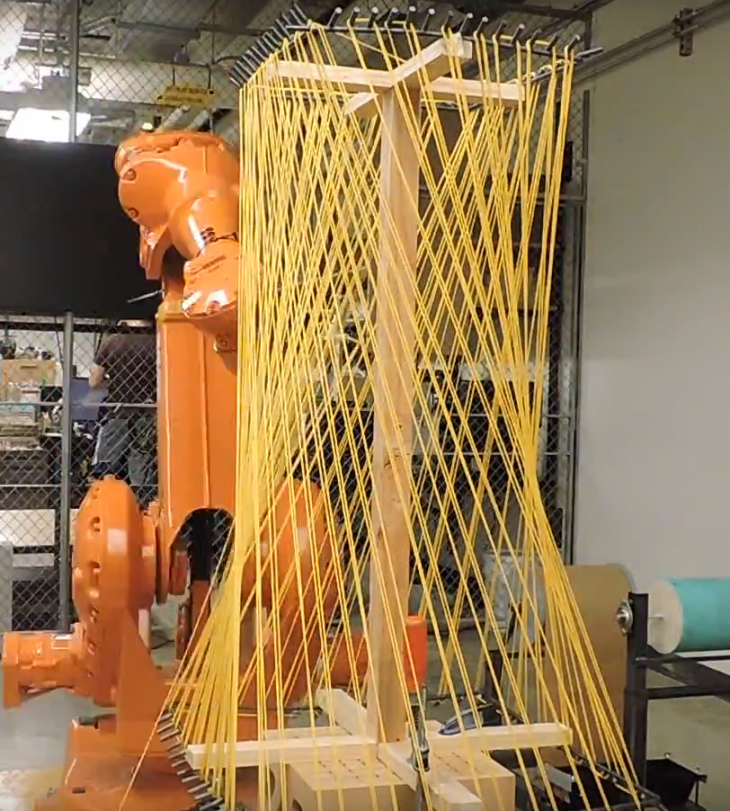REINFORCED CONCRETE PRINTING
Strategies to incorporate reinforcement while printing concrete
CONTEXT
Since the development of 3d printing and additive layering technology, great advancements have been made in their attempts to incorporate that into various means of manufacturing. None so much greater than architecture and the building industry. The technology brought great hope with the ability to utilize contemporary building mediums like clay and concrete to print 3 dimensional structures. But while materials like clay can be easily adopted, r.c.c. poses a special problem. R.c.c. comprises of a compressive component i.e. cement concrete and a tensile component in the form of steel reinforcement.
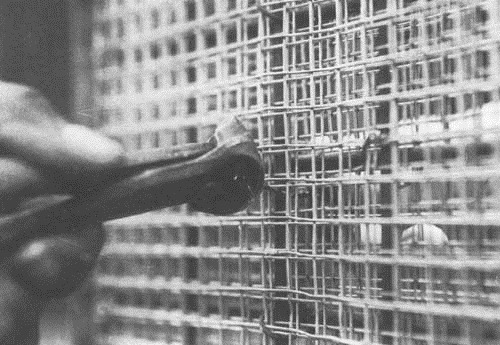
While printing cement concrete for its compressive properties is nearly perfect, the problem remains in incorporating the steel reinforcement in it. While numerous studies have been conducted to incorporate reinforcement into concrete printing either inserting them post printing or by the use of tensile alternatives to steel, none has been successful in trying to incorporate steel simultaneously with concrete during printing
One of the advantages of this process is the total adhesion and encapsulation of the steel prior to curing, that ensures proper bonding bent ween the two elements.
ADDITIVE MANUFACTURING IN CONCRETE
Additive Manufacturing with cement-based materials is an emerging technology that opens opportunities in the construction industry by reducing labor and form-work costs and increasing reliability of concrete infrastructure.
Amongst the early pioneers of concrete printing technology is Contour Crafting by Behrokh Khoshnevis.
CONTOUR CRAFTING
Behrokh Khoshnevis and Contour Crafting have conducted significant research in the 3D printing of a concrete house by the use of additive technology. But much of his research is in the utilization of vertical extrusions. Contour crafting uses quick setting concrete to print the walls layer by layer until its finally topped off by beams and slabs. Much of the structural components, plumbing, wiring etc are inserted into it while printing the layers.
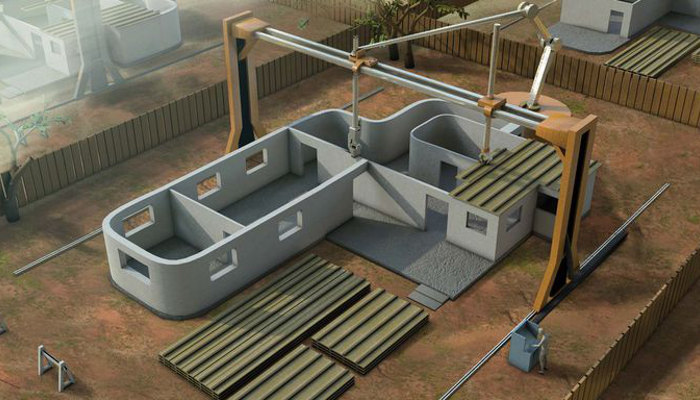
In conventional reinforced cement concrete the rebar utilised are between the size of 6mm – 40mm diameter, which is difficult to incorporate into printing in its current state. Any form of reinforcement that can be adapted to 3d printing technology needs to be of sufficiently small diameter or size to allow for ease of manipulation.
In such situation we can use specialized steel fibers or use specialized concrete like ferrocement which uses mesh reinforcement to gain structural support. While the use of steel fibers increases the tensile strength of concrete, it cannot provide the same degree of support like conventional concrete.
So for the purposes of this study ferrocement was chosen.
WHAT IS FERROCEMENT?
Ferrocement is a form of reinforced concrete composed of closely spaced layersof mesh or steel rods of small diameter encapsulated in mortar used to form thin sections.
The construction process consists of forming the shape of the required structure with a mesh of fine reinforcement,such as chicken wire or expanded metal. Multiple layers may be used to achieve the required density of steel and the whole may be stiffened with a few standard reinforcing bars. A stiff mortar is then applied to both sides of the layer of reinforcement known as the ‘armature’ and finished to the required thickness.
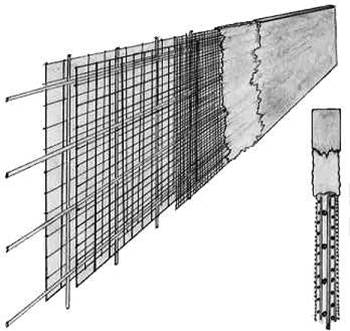
MATERIAL COMPOSITION:
-Cement Mortar mix
-Galvanised wire / mesh aka chicken wire 6mm dia mild steel or tor steel bars for skeletal supposrt as required.
ADVANTAGES:
-Thinner sections.
-Greater flexibility and elasticity.
-Higher tensile properties
-Lower Cost depending on application.
-Less material consumption.
-Can reduce form-work needed.
-Lower labor cost
-Low dependency on tools and machinery
-Lower learning curve. less reliance on skilled labor.
-Greater resistance to earthquakes
DISADVANTAGES:
-Improper casting / curing can lead to corrosion of reinforcement.
-Poor performance against sheer force.
-Fixing reinforcement is time consuming.
HYPOTHESIS
“Can specialized reinforced cement concrete like ferro-cement be printed continuously and in situ while incorporating its reinforcement in the printing process at real time by incorporating methods of mesh-weaving and layer printing through a multi – nozzle or a concentric nozzle delivery system.”
CASE STUDIES
SCRIM
Sparse Concrete Reinforcement in Meshworks
Authors: Phil Ayres, Wilson Ricardo Leal da Silva, Paul Nicholas, Thomas Juul Anderson, Johannes Portielje Rauff Greisen
Publication: Robotic Fabrication in Architecture, Art and Design
Link:
https://www.researchgate.net/publication/327234503_SCRIM_-_Sparse_Concrete_Reinforcement_in_Meshworks
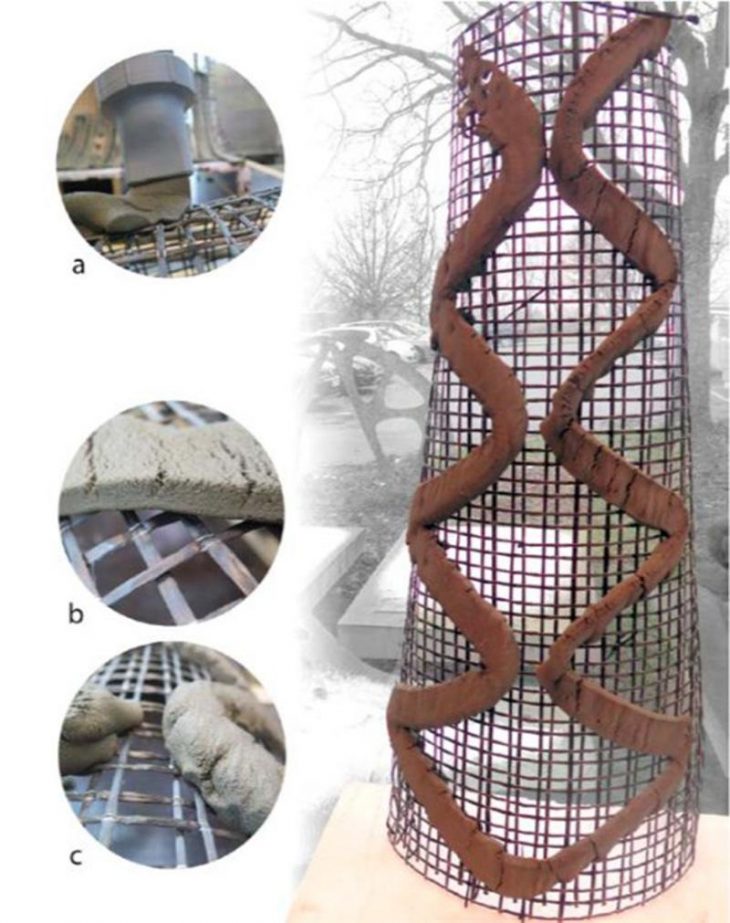
SCRIM, introduces a new concept that intersects robot based 3D Concrete Printing and textile reinforcement meshes to produce lightweight elements. Existing 3DCP stacks material vertically. SCRIM tries to utilize 6-axis robotic control by using supportive meshes to define 3D surfaces onto which concrete is selectively deposited at various angles. SCRIM does not encapsulate the textile in concrete. It deposits it sparsely.
Conventional concrete works on adding tensile reinforcement (sparsely) in a compressive medium. This uses a system of adding compressive properties to a tensile structure.
SCRIM can offer near vertical material deposition.Resolution of the challenge to integrate reinforcement by inverting the process.Removes time dependency of printing on previously extruded layers
Limits: Mesh needs tensioning and exhibits deformation when load is applied (self load). This leads to layer height irregularities that leads to problems in mesh encapsulation and adhesion. Complex toolpaths need to be defined. Study of curing not conducted along with their performance.
MESH-MOULD
Robotically Fabricated Spatial Meshes As Concrete Formwork and Reinforcement
Authors: Norman Hack, Willi Viktor Lauer, Fabio Gramazio, Mathias Kohler, Silke Langenberg
Publication: Fabricate
Link:
https://www.researchgate.net/publication/281966796_Mesh-Mould_Differentiation_for_Enhanced_Performance
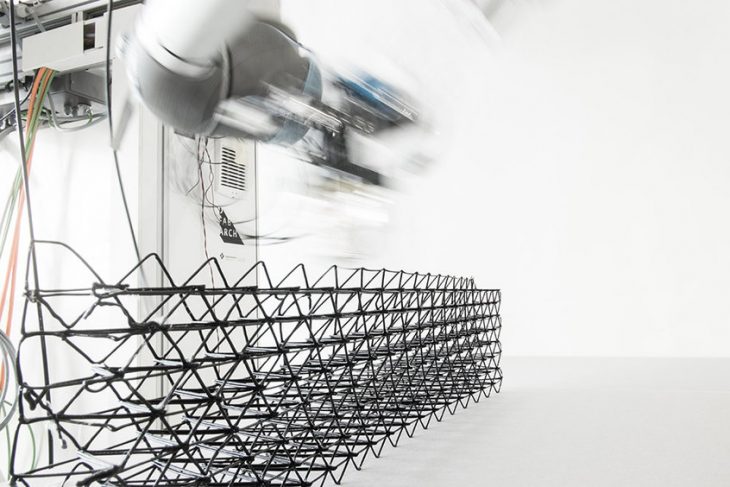
Concrete requires formwork to cast and reinforcement to compensate for tensional forces, both of which are expensive and labour intensive. Due to this concrete is cast in simple forms and not allowed to explore its true potential. Mesh mould investigates a technique of intricately weaving a tensile material that acts as form defining mould and reinforcement. Labor for formwork and reinforcement accounts for 50% of the cost and it rises expontially along with geometric complexity. Industrial robots which can precisely and swiftly execute spatial movements regardless of complexity can unlock the full potential of concrete as building material.
If the perforated formwork is directly extruded in situ as a three dimensional spatial meshes by a robotic arm instead of discrete panels the the system is freed from planarity or single curvature. This allows the fabrication of 3 dimensional meshes as formwork.
Steps to substitute steel reinforcement:
1. explore form defining capacity and spatial extrusion of polymers.
2. Substitute secondary reinforcement
3. fabrication and material research can converge to remove entire tensional reinforcement of concrete.
DUCTILITY OF 3D PRINTED CONCRETE REINFORCED WITH SHORT STRAIGHT STEEL FIBERS
Authors: F. P. Bos, E. Bosco & T. A. M. Salet
Publication: Virtual and Physical Prototyping · November 2018
Link:
https://www.researchgate.net/publication/329082843_Ductility_of_3D_printed_concrete_reinforced_with_short_straight_steel_fibers
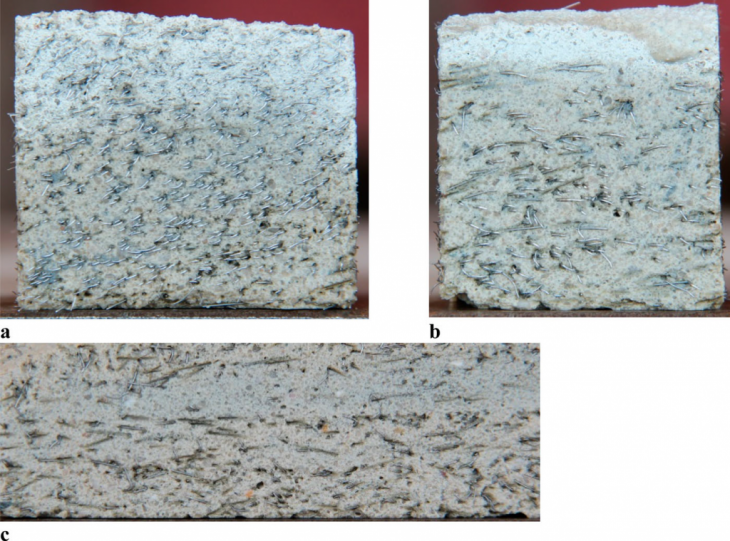
The study explores the structural performance of Steel Fiber Reinforced concrete (SFRC) applied in a particular Digital Fabrication Concrete (DFC) process, namely the ‘3D Concrete Printing (3DCP)’ Fused Deposition Modelling (FDM) process that is being developed at the Eindhoven University of Technology.
It should be expected that normal strength concrete with short straight steel fibers will show increased tensile strength due to delayed macro-crack development. The increased tensile strength, fracture toughness, and failure strain may nevertheless be beneficial for many practical applications, and improve structural performance in statically indeterminate structures.
The research has shown the fibers cause an important increase in flexural strength, and eliminate the strength difference between cast and printed concrete without fibers. The post-peak behaviour, nevertheless, has to be characterised as strongly strain-softening. In the printed specimens, a strong fiber orientation in the direction of the filament
occurs.
3D PRINTING CONCRETE WITH REINFORCEMENT
Authors: Freek P. Bos, Zeeshan Y. Ahmed, Rob J.M. Wolfs,
and Theo A.M. Salet
Publication: Researchgate.com
Link:
https://www.researchgate.net/publication/322168435_3D_Printing_Concrete_with_Reinforcement
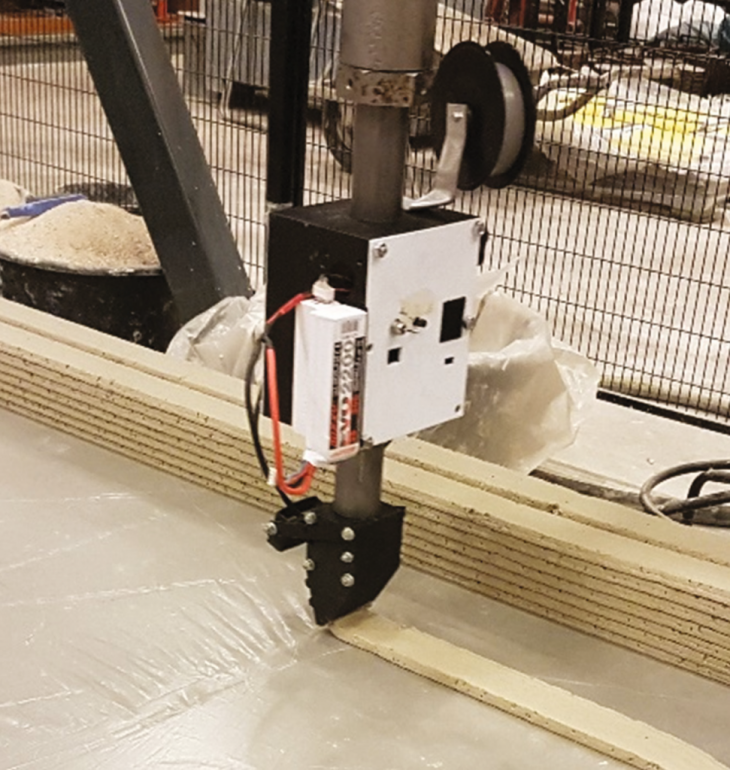
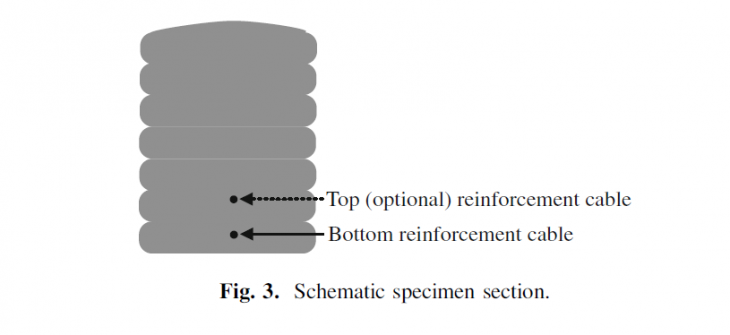
One of the major difficulties blocking large scale application, is the lack of ductility or post-peak capacity of 3D printed concrete. This is due to the fact that conventional reinforcement, with which ductility is usually obtained in structural concrete, can not (yet) be incorporated into the existing concrete additive manufacturing systems. In the limited number of projects that have been realized up to now, the strategy generally is to use the printed concrete as lost mould for conventional
reinforced concrete
The 3D concrete printing system adopted by the TU/e has been described extensively by (Bos et al. 2016). It consists of a M-Tec Duomix 2000 mixer-pump with a linear displacement pump that feeds concrete by a Ø25 mm hose to a 9.0 4.5 2.8 m 4-DOF gantry robot (Fig. 1). For this project, the printer head, which previously consisted of a simple stainless steel print nozzle, was expanded with a device that allows the introduction of a reinforcement medium to the concrete filament.
A device was developed to directly entrain a reinforcement medium into filament of printed concrete. The devices uses a servo-motor driven spool that feeds steel reinforcementcable into the concrete filament just before it leaves the print nozzle. Four-point bending tests on beams with a 620 mm span and different cable types and configurations, show significant post-crack moment capacity and deformations are obtained.
THEORETICAL FRAMEWORK
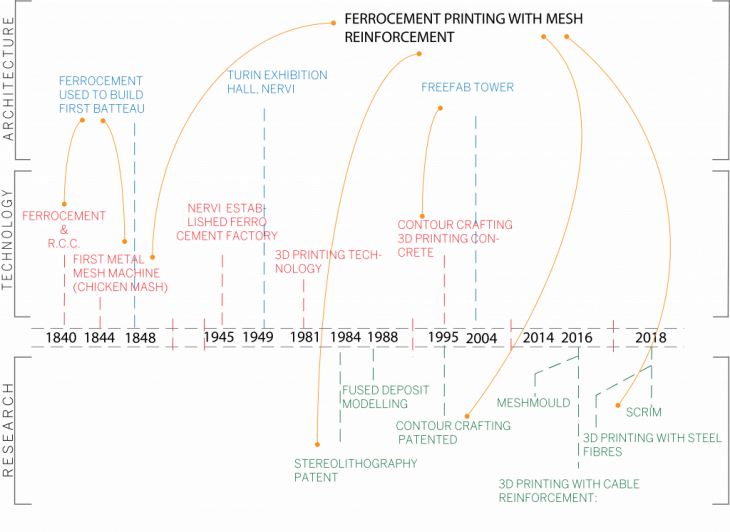
STRATEGIES TO INCORPORATE REINFORCEMENT USING CURRENT TECHNOLOGY
WIRE BENDING
Wire bending technology could be incorporated in the weaving of metal mesh
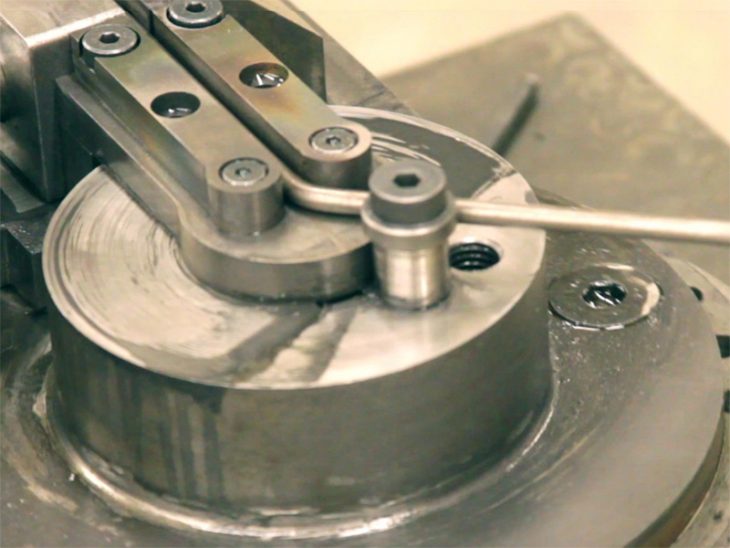
ROBOTIC WEAVING
The base framework could be created and the reinforcement could be woven by a robotic arm. A concrete extruder could then print over the woven mesh.
POLYMER MESH WITH MULTI NOZZLE EXTRUSION
Polymer mesh can be extruded using a polymer extruder simultaneously along with concrete.
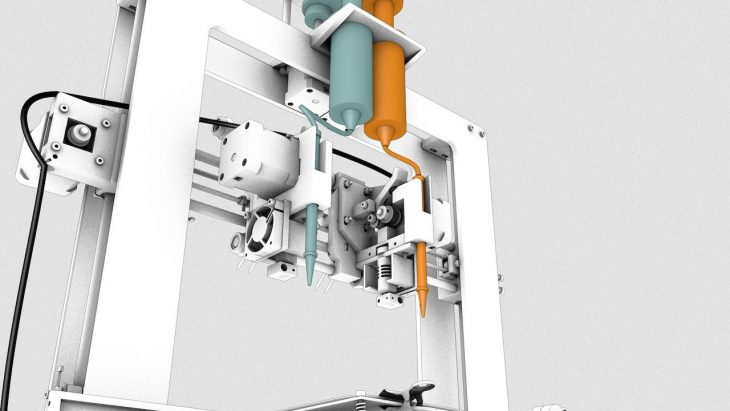
The method to infuse reinforcement will require research and strategies developed by various technologies, including marrying of separate methods to achieve the desired result.
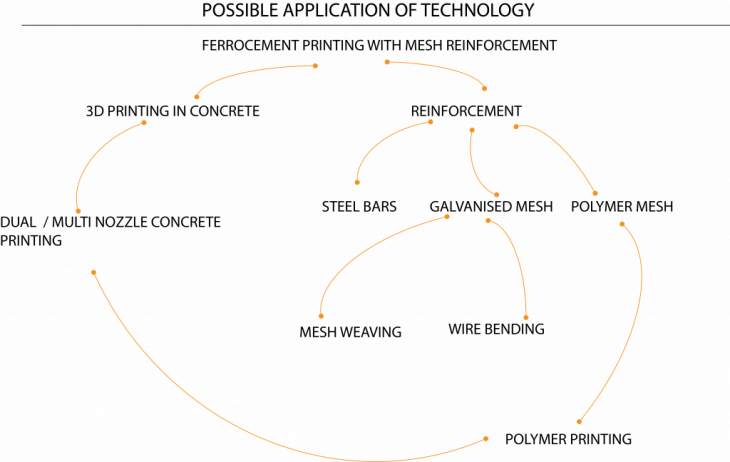
FUTURE STEPS:
The next steps would be to test the above technology and device strategies to simultaneously incorporate galvanised steel wires or polymer based reinforcement while ferrocement printing.
Reinforced Concrete Printing is a project of IaaC, Institute for Advanced Architecture of Catalonia developed at Master in Robotics and Advanced Construction (M.R.A.C.) in 2018 by,
Students: Sujay Kumarji
Faculty: Ricardo Devesa
